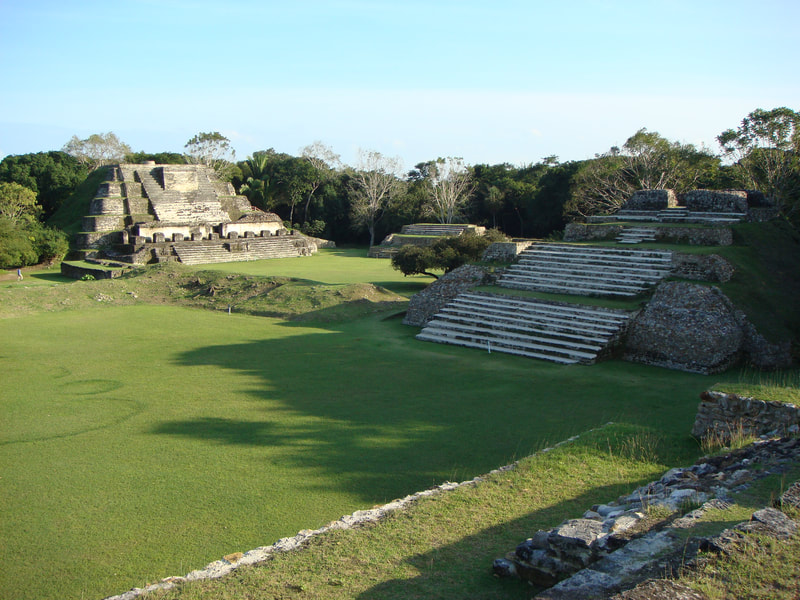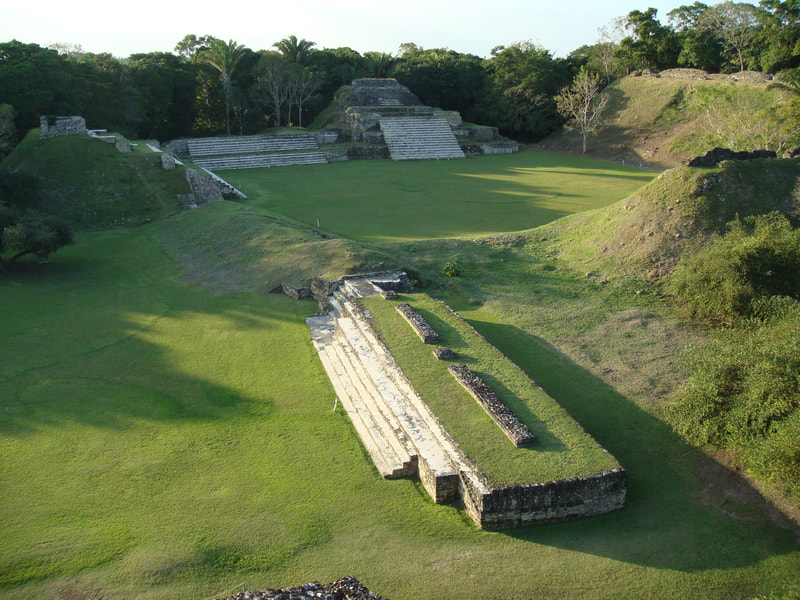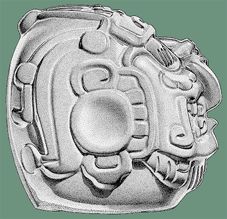ALTUN HA
is the name given to the site of an ancient Maya city in Belize, located about 20 miles (as the crow flies)
northwest of Belize City on the Old Northern Highway and about 8 miles west of the shore of the Caribbean Sea.
is the name given to the site of an ancient Maya city in Belize, located about 20 miles (as the crow flies)
northwest of Belize City on the Old Northern Highway and about 8 miles west of the shore of the Caribbean Sea.
Altun Ha Site Map. Structure B-4 is the tallest of the several central-precinct temples, on the east side of the B Group, and it is the structure in which the Jade Head was found.
(Louise Belanger enhanced site map after Pendergast’s 1979; in Altun Ha: A Guide to the Ruins, Pendergast 2017. Published by LamanaiArt 2017).
(Louise Belanger enhanced site map after Pendergast’s 1979; in Altun Ha: A Guide to the Ruins, Pendergast 2017. Published by LamanaiArt 2017).
ALTUN HA
Early in 1963 the attention of Belize's first archaeological commissioner, A. H. Anderson, was drawn to the coastal-zone site now known as Altun Ha when a villager from Rockstone Pond attempted to sell a large carved jade pendant he had unearthed at the site to tourists in Belize City. Anderson contacted David Pendergast, who had carried out work in the country's western district at the beginning of that year, and in late summer Pendergast began test excavations at the site. Shortly thereafter Pendergast was invited by the Royal Ontario Museum to lead the revival of the museum's research programme in Belize, and discussions led to the ROM's commencement of full-scale excavations at Altun Ha under his direction in January of 1964. The project, financed by the museum, the Wenner-Gren Foundation, the Globe and Mail, and The Canada Council (later the Social Sciences and Humanities Research Council of Canada), continued through 1970, with a season of laboratory work in the following year. At the time it was the largest-scale and longest-term archaeological endeavour ever carried out in Belize.
The 1968 season brought the project's most spectacular discovery, in the form of a 14.9 cm-high, 4.42 kg jade head of the Maya sun god, Kinich Ahau. The giant jade lay atop the right wrist of the person interred in the earliest of a series of seven royal tombs encountered in Altun Ha's Structure B-4, the Temple of The Masonry Altars. The tomb, which lay deep beneath a giant central stair block that dominates the upper part of the structure, was of the characteristic Altun Ha form, with an earthen floor, boulder walls, and giant chert slabs as the roof. In addition to the jade head the crypt contained numerous smaller jade objects, several large modified Spondylus oyster shells, and five polychrome and bichrome pottery vessels. Fragmentary remains showed that the ruler's body was once covered with several skins of large felids, probably jaguar and cougar, and that a corner of the crypt had contained a large pile of cloth, matting, and other perishables. Bits of cloth, probably parts of the individual's garments, lay around the skeleton, impregnated with the red pigment that covered the entire burial. Beneath the crypt contents stood the remains of a large, round-cornered wooden platform with short cylindrical legs, under which were impressions of large cables used to lower the device into the crypt. Excavation below the earth floor revealed three groups of large ceremonial flints, a further pottery vessel, a pyrite mirror, and the remains of two stucco-coated wooden or gourd bowls with polychrome decoration. The jade head, famous almost from the moment of its discovery, has now become the national symbol of Belize, and appears on the country's currency.
Early in 1963 the attention of Belize's first archaeological commissioner, A. H. Anderson, was drawn to the coastal-zone site now known as Altun Ha when a villager from Rockstone Pond attempted to sell a large carved jade pendant he had unearthed at the site to tourists in Belize City. Anderson contacted David Pendergast, who had carried out work in the country's western district at the beginning of that year, and in late summer Pendergast began test excavations at the site. Shortly thereafter Pendergast was invited by the Royal Ontario Museum to lead the revival of the museum's research programme in Belize, and discussions led to the ROM's commencement of full-scale excavations at Altun Ha under his direction in January of 1964. The project, financed by the museum, the Wenner-Gren Foundation, the Globe and Mail, and The Canada Council (later the Social Sciences and Humanities Research Council of Canada), continued through 1970, with a season of laboratory work in the following year. At the time it was the largest-scale and longest-term archaeological endeavour ever carried out in Belize.
The 1968 season brought the project's most spectacular discovery, in the form of a 14.9 cm-high, 4.42 kg jade head of the Maya sun god, Kinich Ahau. The giant jade lay atop the right wrist of the person interred in the earliest of a series of seven royal tombs encountered in Altun Ha's Structure B-4, the Temple of The Masonry Altars. The tomb, which lay deep beneath a giant central stair block that dominates the upper part of the structure, was of the characteristic Altun Ha form, with an earthen floor, boulder walls, and giant chert slabs as the roof. In addition to the jade head the crypt contained numerous smaller jade objects, several large modified Spondylus oyster shells, and five polychrome and bichrome pottery vessels. Fragmentary remains showed that the ruler's body was once covered with several skins of large felids, probably jaguar and cougar, and that a corner of the crypt had contained a large pile of cloth, matting, and other perishables. Bits of cloth, probably parts of the individual's garments, lay around the skeleton, impregnated with the red pigment that covered the entire burial. Beneath the crypt contents stood the remains of a large, round-cornered wooden platform with short cylindrical legs, under which were impressions of large cables used to lower the device into the crypt. Excavation below the earth floor revealed three groups of large ceremonial flints, a further pottery vessel, a pyrite mirror, and the remains of two stucco-coated wooden or gourd bowls with polychrome decoration. The jade head, famous almost from the moment of its discovery, has now become the national symbol of Belize, and appears on the country's currency.
The jade head of Kinich Ahau from Tomb B-4/7, Mac Phase, ca A.D. 600; side view.
Height 14.9 cm. Drawing by David Findlay.
Height 14.9 cm. Drawing by David Findlay.
LINKS
https://nichbelize.org/institute-of-archaeology/archaeological-sites-and-parks/altun-ha/
http://louisebelanger.com Search for Altun Ha Guidebook
PUBLICATIONS
Pendergast, David M.
[PDF] 1965-1989 Altun Ha Royal Ontario Museum Archaeological Newsletters.
1979 Excavations at Altun Ha, Belize, 1964–1970, Vol. 1. Royal Ontario Museum, Toronto.
1982 Excavations at Altun Ha, Belize, 1964–1970, Vol. 2. Royal Ontario Museum, Toronto.
1983 Excavations at Altun Ha, Belize, 1964–1970, Vol. 3. Royal Ontario Museum, Toronto.
2017 Altun Ha: A Guide to the Ruins. Published by LamanaiArt 2017 (https://louisebelanger.com/guidebooks/#2).
2014 Ting, Carmen, Elizabeth Graham & Marco Martinón Torres. Molding the ‘collapse’: Technological analysis of the Terminal Classic molded-carved vases from Altun Ha, Belize. In Craft and science: International perspectives on archaeological ceramics, ed. M. Martinón Torres, 53-64. UCL Qatar Series in Archaeology and Cultural Heritage 1. Bloomsbury Qatar Foundation, Doha, Qatar. http://www.qscience.com/page/books/uclq-cas
2009 Ting, Carmen, Elizabeth Graham, Marcos Martinón Torres. Moulding the 'Collapse': Technological Characterization of the Terminal Classic Ahk'utu' Moulded-carved Vases from Altun Ha, Belize. 10th European Meeting on Ancient Ceramics, The British Museum and UCL, 10-13 September, London.
https://nichbelize.org/institute-of-archaeology/archaeological-sites-and-parks/altun-ha/
http://louisebelanger.com Search for Altun Ha Guidebook
PUBLICATIONS
Pendergast, David M.
[PDF] 1965-1989 Altun Ha Royal Ontario Museum Archaeological Newsletters.
1979 Excavations at Altun Ha, Belize, 1964–1970, Vol. 1. Royal Ontario Museum, Toronto.
1982 Excavations at Altun Ha, Belize, 1964–1970, Vol. 2. Royal Ontario Museum, Toronto.
1983 Excavations at Altun Ha, Belize, 1964–1970, Vol. 3. Royal Ontario Museum, Toronto.
2017 Altun Ha: A Guide to the Ruins. Published by LamanaiArt 2017 (https://louisebelanger.com/guidebooks/#2).
2014 Ting, Carmen, Elizabeth Graham & Marco Martinón Torres. Molding the ‘collapse’: Technological analysis of the Terminal Classic molded-carved vases from Altun Ha, Belize. In Craft and science: International perspectives on archaeological ceramics, ed. M. Martinón Torres, 53-64. UCL Qatar Series in Archaeology and Cultural Heritage 1. Bloomsbury Qatar Foundation, Doha, Qatar. http://www.qscience.com/page/books/uclq-cas
2009 Ting, Carmen, Elizabeth Graham, Marcos Martinón Torres. Moulding the 'Collapse': Technological Characterization of the Terminal Classic Ahk'utu' Moulded-carved Vases from Altun Ha, Belize. 10th European Meeting on Ancient Ceramics, The British Museum and UCL, 10-13 September, London.




